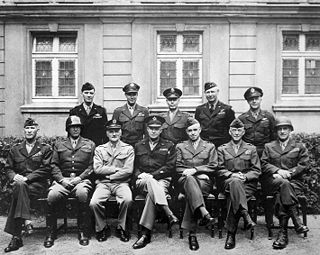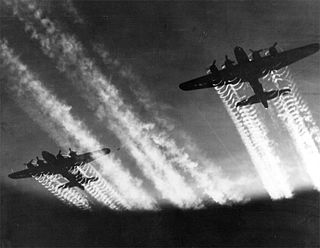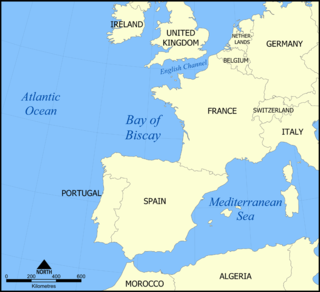Topics of discussion and agreements
Churchill opened the discussion with ideas, which were discussed in an open manner between the two countries. The main topics that were discussed were the Italian Campaign, the amount of military force that should be used, the Normandy landings, and how to help China in the Pacific War. Churchill felt that the extent of the operations and their priority could be solved by mutual agreement, [5] and consensus was reached on all issues. [6]
The Italian campaign
The first topic discussed was the war in Italy. Churchill persuaded the American leaders to endorse the Allied invasion of Sicily. [7] He believed that the fighting in Italy would distract the German troops from the Eastern Front so that Russia would be given breathing room since the Germans would need to send a large number of troops to the Balkans. [5] This would get rid of the Allies' debt to Russia from Russia's heavy engagement of German forces in Stalingrad. [5]
Getting Italy out of the war would also help the Allies' relationship with Turkey. Turkey could no longer compete with Italy in the Mediterranean. Churchill believed that they could ask Turkey for use of their bases for future defense. [5]
Extent of military force
The next objective discussed was the extent of the military force that the Allies should use. Both countries agreed that they should use the greatest amount of military force against the enemy, including armies, air forces and munitions. Unconditional surrender, first mentioned at the Casablanca Conference, was debated again at Trident. Both Trident and Casablanca had competitive atmospheres due to the differing views on unconditional surrender. Roosevelt was persistent against American General Dwight D. Eisenhower and British General Henry Maitland Wilson's anti-unconditional views of surrender. [8]
Despite these opposing views, after much consideration, the Allies agreed that they wanted to carry the war to Japan. They believed that Germany would be out of the war in 1944, so they would need to concentrate on defeating Japan in 1945. [5] The best solution would be involving Russia in the fight against Japan because Stalin had indicated his interest in taking part in Japan's defeat. [5]
The Normandy landings
The Normandy landings were postponed for 12 months to May 1944. This was because the US and the UK speculated that they could build up troop strength, produce more landing craft and supplies, and thus ensure complete command of air and sea by doing so. [9] They discussed the difficult beaches with large tides, the large German enemy defenses, the optimal timing to attack, and relevant weather conditions.
The main reason why the Allies wanted to postpone the landings was because of their lack of supplies in 1943. All the British landing craft had been deployed to Operation Husky, and only one US Division was available due to a higher priority of Operation Sickle in the war. [5]
Aid to China
Lastly, the US and the UK decided what to do in the Pacific War. British Field Marshal Wavell visited Burma and helped brace the Allies for the many obstacles they would face, including:
- the thick jungle preventing the use of modern weapons
- the monsoons that limited the amount of potential attack time
- few options for naval support
Other than air support, there were few alternatives to help China, so efficient planning was necessary. The countries agreed it would be better to by-pass a ground attack in Burma and instead use the element of surprise by air attack, as in Operation Torch. [5] The fleet from Italy was to cover this operation in March 1944. [5]
Other results
The Trident Conference shows a change in domination over world leadership, as the Americans were influential over other countries. American initiatives received twice the amount of Allied military resources, while Britain had to compromise on several of their requests. [4] In particular, US Army Chief of Staff General George Marshall led this change to increase the role of the Americans in the war effort, which had been previously dominated by Britain. [10]
However, the actions after Sicily still remained unsettled. Churchill wanted an Italian Campaign to follow, but Roosevelt worried that the campaign might delay the strategic plans for recapturing France that had been planned for the following year. [10] According to Max Hastings, Brooke's reputation as a strategist was "significantly damaged" by his remarks at the Trident Conference, where he claimed that no major operations on the continent would be possible until 1945 or 1946. [11] Brooke's diary says that he wanted operations in the Mediterranean to force a dispersal of German forces, help Russia, and thus eventually produce a situation where cross Channel operations are possible but that Churchill entirely repudiated (or half repudiated) the paper we (the CCOS) had agreed on; Harry Hopkins got him to withdraw his proposed amendments but Churchill had aroused suspicions with his talk of ventures in the Balkans. [12]

The Tehran Conference was a strategy meeting of Joseph Stalin, Franklin D. Roosevelt, and Winston Churchill from 28 November to 1 December 1943. It was held at the Soviet Union's embassy at Tehran in Iran. It was the first of the World War II conferences of the "Big Three" Allied leaders and closely followed the Cairo Conference, which had taken place on 22–26 November 1943, and preceded the 1945 Yalta and Potsdam conferences. Although the three leaders arrived with differing objectives, the main outcome of the Tehran Conference was the Western Allies' commitment to open a second front against Nazi Germany. The conference also addressed the 'Big Three' Allies' relations with Turkey and Iran, operations in Yugoslavia and against Japan, and the envisaged postwar settlement. A separate contract signed at the conference pledged the Big Three to recognize Iranian independence.

Operation Torch was an Allied invasion of French North Africa during the Second World War. Torch was a compromise operation that met the British objective of securing victory in North Africa while allowing American armed forces the opportunity to begin their fight against Nazi Germany and Fascist Italy on a limited scale. It was the first mass involvement of US troops in the European–North African Theatre and saw the first big airborne assault carried out by the United States.

The European Theater of Operations, United States Army (ETOUSA) was a theater of Operations responsible for directing United States Army operations throughout the European theatre of World War II, from 1942 to 1945. It commanded Army Ground Forces (AGF), United States Army Air Forces (USAAF), and Army Service Forces (ASF) operations north of Italy and the Mediterranean coast. It was bordered to the south by the North African Theater of Operations, United States Army (NATOUSA), which later became the Mediterranean Theater of Operations, United States Army (MTOUSA).

The Cairo Conference also known as the First Cairo Conference, was one of the 14 summit meetings during World War II that occurred on November 22–26, 1943. The Conference was held at Cairo in Egypt between China, the United Kingdom and the United States. It outlined the Allied position against the Empire of Japan during World War II and made decisions about post-war Asia. The conference was attended by Chairman Chiang Kai-shek, British Prime Minister Winston Churchill and US President Franklin D. Roosevelt.
Operation Sledgehammer was an Allied plan for a cross-Channel invasion of Europe during World War II, as the first step in helping to reduce pressure on the Soviet Red Army by establishing a Second Front. It was to be executed in 1942 and acted as a contingency alternative to Operation Roundup, the original Allied plan for the invasion of Europe in 1943. Allied forces were to seize the French Atlantic ports of either Brest or Cherbourg and areas of the Cotentin Peninsula during the early autumn of 1942, and amass troops for a breakout in the spring of 1943.

The First Quebec Conference, codenamed Quadrant, was a highly secret military conference held during World War II by the governments of the United Kingdom, Canada, and the United States. It took place in Quebec City on August 17–24, 1943, at both the Citadelle and the Château Frontenac. The chief representatives were Winston Churchill and Franklin D. Roosevelt, hosted by the Canadian prime minister William Lyon Mackenzie King.

The Casablanca Conference or Anfa Conference was held in Casablanca, French Morocco, from January 14 to 24, 1943, to plan the Allied European strategy for the next phase of World War II. The main discussions were between US President Franklin Roosevelt and British Prime Minister Winston Churchill. Stalin could not attend. Key decisions included a commitment to demand Axis powers' unconditional surrender; plans for an invasion of Sicily and Italy before the main invasion of France; an intensified strategic bombing campaign against Germany; and approval of a US Navy plan to advance on Japan through the central Pacific and the Philippines. The last item authorized the island-hopping campaign in the Pacific, which shortened the war. Of all the decisions made, the most important was the invasion of Sicily, which Churchill pushed for in part to divert American attention from opening a second front in France in 1943, a move that he feared would result in very high Allied casualties and not be possible until 1944.
Operation Roundup was the codename for a plan to invade Northern France in the spring of 1943 prepared by Allied forces during World War II.

The military history of the United States during World War II covers the nation's role as one of the major Allies in their victory over the Axis Powers. The United States is generally considered to have entered the conflict with the 7 December 1941 surprise attack on Pearl Harbor by the Empire of Japan and exited it with the 2 September 1945 surrender of Japan. During the first two years of World War II, the US maintained formal neutrality, which was officially announced in the Quarantine Speech delivered by US President Franklin D. Roosevelt in 1937. While officially neutral, the US supplied Britain, the Soviet Union, and China with war materiel through the Lend-Lease Act signed into law on 11 March 1941, and deployed the US military to replace the British forces stationed in Iceland. Following the 4 September 1941 Greer incident involving a German submarine, Roosevelt publicly confirmed a "shoot on sight" order on 11 September, effectively declaring naval war on Germany and Italy in the Battle of the Atlantic. In the Pacific Theater, there was unofficial early US combat activity such as the Flying Tigers.

Operation Overlord was the codename for the Battle of Normandy, the Allied operation that launched the successful liberation of German-occupied Western Europe during World War II. The operation was launched on 6 June 1944 (D-Day) with the Normandy landings. A 1,200-plane airborne assault preceded an amphibious assault involving more than 5,000 vessels. Nearly 160,000 troops crossed the English Channel on 6 June, and more than two million Allied troops were in France by the end of August.

This is a timeline of events that occurred during World War II in 1943.
The Second Washington Conference, did not have a code name because it was hastily called and was regarded at the time as a set of military staff conversations rather than a formal conference. The two delegations were led by the British Prime Minister Winston Churchill and the American President Franklin D. Roosevelt.

Operation Turkey Buzzard, also known as Operation Beggar, was a British supply mission to North Africa that took place between March and August 1943, during the Second World War. The mission was undertaken by No. 2 Wing, Glider Pilot Regiment and No. 295 Squadron Royal Air Force, prior to the Allied invasion of Sicily. Unusually, the mission was known by different names in different branches of the British Armed Forces: the British Army called the operation "Turkey Buzzard", while in the Royal Air Force it was known as "Beggar".
The following is a timeline of the first premiership of Winston Churchill, who was the Prime Minister of the United Kingdom from 1940 to 1945 and again from 1951 to 1955. Churchill served as the Prime Minister of the United Kingdom during the bulk of World War II. His speeches and radio broadcasts helped inspire British resistance, especially during the difficult days of 1940–41 when the British Commonwealth and Empire stood almost alone in its active opposition to Nazi Germany. He led Britain as Prime Minister until victory over Nazi Germany had been secured.

The UK-US relations in World War II comprised an extensive and highly complex relationships, in terms of diplomacy, military action, financing, and supplies. British Prime Minister Winston Churchill and American President Franklin D. Roosevelt formed close personal ties, that operated apart from their respective diplomatic and military organizations.

During World War II, Morocco, which was then occupied by France, was controlled by Vichy France from 1940 to 1942 after the occupation of France by Nazi Germany. However, after the North African campaign, Morocco was under Allied control and thus was active in Allied operations until the end of the war.

Winston Churchill was appointed First Lord of the Admiralty on 3 September 1939, the day that the United Kingdom declared war on Nazi Germany. He succeeded Neville Chamberlain as prime minister on 10 May 1940 and held the post until 26 July 1945. Out of office during the 1930s, Churchill had taken the lead in calling for British re-armament to counter the growing threat of militarism in Nazi Germany. As prime minister, he oversaw British involvement in the Allied war effort against the Axis powers. Regarded as the most important of the Allied leaders during the first half of the Second World War, Historians have long held Churchill in high regard as a victorious wartime leader who played an important role in defending Europe's liberal democracy against the spread of fascism. For his wartime leadership and for his efforts in overseeing the war effort, he has been consistently ranked both by scholars and the public as one of the top three greatest British prime ministers, often as the greatest prime minister in British history.
The French Civil and Military High Command was an administrative and military governing body in Algiers that was created in connection with the Allied landings in French North Africa on 7 and 8 November 1942 as part of Operation Torch. It came about as a result of negotiations between the Americans and two military figures from Vichy France whom the Americans believed could assure safe passage for the landing forces, namely Henri Giraud and François Darlan.














